Pearls: the Gem of Gods & Mortals
The tears of the gods, and the obsession of Julius Caesar ~ Join me as we dive into the fascinating (if long) history of pearls.
“See these pearls, that long have slept;
These were the tears by Naiads wept […]
Treasured them, till hard and white
As the teeth of Amphitrite.”
— Sir Walter Scott, The Bridal of Triermain, canto XXVI
Long known as the “Queen of Gems,” pearls have enamored jewelry lovers for millennia. Since the time of the ancient Greeks pearls were considered to be more valuable than any other gemstone or precious material, including gold or diamonds! No matter what Marilyn says, it was pearls that were considered to be the best-loved gem throughout history. Seneca once wrote of a woman who “loved her pearls more than her sons!” In fact, it is well documented that Julius Caesar himself was obsessed with pearls!
We’ll get to that in a moment, it’s quite a story.
They were so popular in the ancient world that the Roman author Pliny the Elder even stated: “The first rank then, and the very highest position among all valuables, belongs to the pearl.”1 For the fourth installment of The Jewelry Casket, we are going to talk about one of my favorite gemstones, the pearl. This is a long one, so brew the coffee and tea, and get cozy — andiamo!
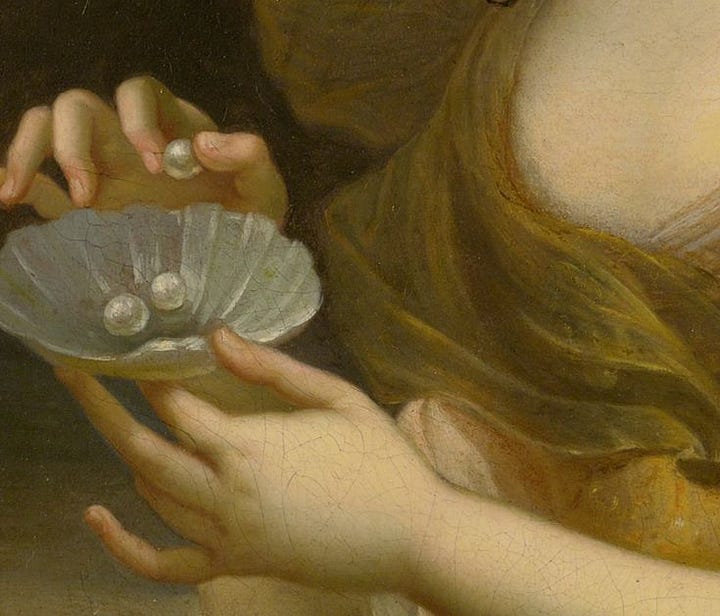
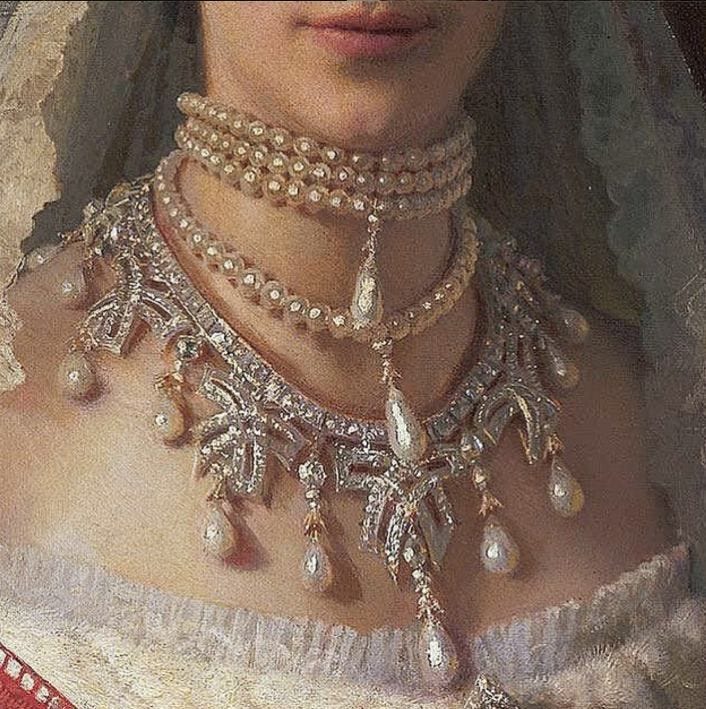
Pearls of Wisdom
Cherished for their rarity, beauty, and lustrousness, pearls have appeared in art, jewelry, and mythical stories across cultures since they were first recorded in 2206 BCE by a historian in ancient China.2
It’s a GEM but not a STONE: Like amber and coral, pearls are ‘organic gems,’ and are made by living creatures.
Pearls are created when an irritant [also called a nucleus] lodges itself in the mantle or soft tissue of a living mollusk. The mollusk's mantle tissue (a thin layer of flesh that lines its shell) reacts by forming a sac and begins to coat nacre over the irritant, which eventually forms a pearl.3
Bear with me on this! The nucleus (irritant) is what triggers the process, acts as the pearl’s core, and as a template for its final shape. The rounder the nucleus the rounder the pearl! This is true for both natural and cultured pearls which are chemically and physically, exactly the same. It's also why getting a perfectly round pearl is difficult and rare.


It’s Baroque, Don’t Fix It
The formation of baroque pearls (any irregularly shaped pearl) occurs when the nacre-layering process is interrupted by sudden changes in temperature or the environment. This causes the nacre to become…unpredictable, and results in the beautiful irregular shapes that characterize baroque pearls!
In the 16th and 17th centuries, the rage for pearls was at a fever pitch! Baroque pearls especially, were utilized to make some of the most interesting and fashionable pieces of the time. I’m talking about those fantastical Renaissance baroque pearl pendants, in which the pearl’s shape is cleverly used to determine the design. Precious gemstones, gold, and enamel work would be included to create detailed miniature sculptures of sirens, tritons, gods, mythical beasts, and even ordinary animals.
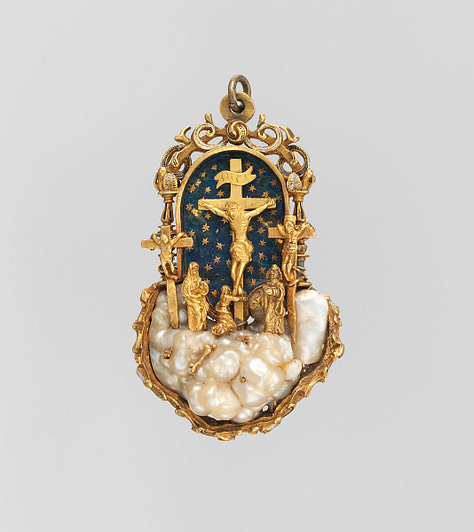
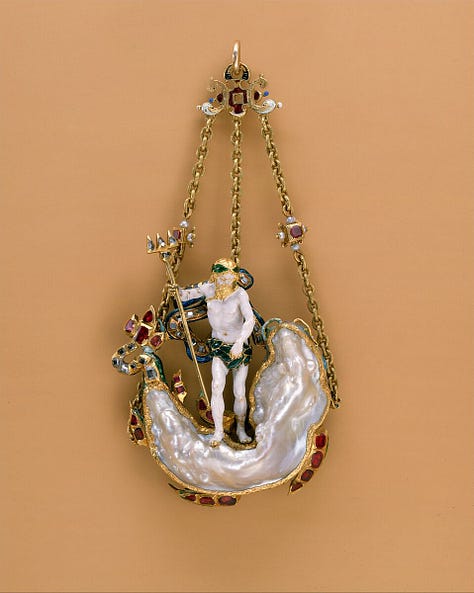
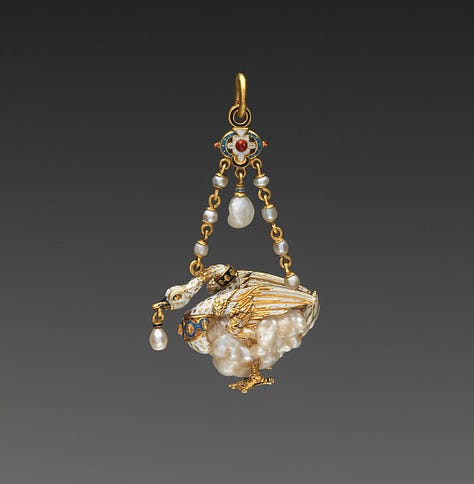
These jewels were worn as pendants or brooches. They are truly an ingenious use of the baroque pearl. If I had to pick a favorite, it would be the Swan, it looks incredibly grumpy and endearing.
Some of the most remarkable shapes, however, come from the so-called Keshi pearls, which are formed when the oyster rejects or fractures the implanted irritant before the culturing process is completed. These pearls do not have a nucleus, and so, develop odd (but fun!) shapes: crosses, sticks, hearts, buttons, and chicken feet (yes, you read that correctly).
The Black Pearl & Some Roman Gossip
Although most pearls in art and jewelry are creamy white, pearls can appear in a range of colors that few gems match: black, blue, silver, pink, purple, brown, gold, and even green; determined by the color of the mollusk’s “lip” or outer shell.
One of the most famous pearls in history was actually a black one. Known as “Servilia’s pearl,” this exceptional gem was given by Julius Caesar to his favorite mistress, Servilia who was the mother of his future murderer, Brutus. Caesar purchased the pearl at a whopping 6 million sesterces making it one of the most valuable gems of all time!4
Caesar was known as quite the pearl connoisseur. Roman critic (gossiper) Suetonius once snidely called Caesar's invasion of Britain a glorified search for pearls. It may sound juicy, but it's not entirely true. More likely, he aimed to overshadow Pompey, who is credited by Pliny the Elder with giving the Romans a taste for pearls.5
Pompey the Great was a Roman general who, in 61 BCE, defeated Mithradates, King of Pontus. He is said to have displayed “33 pearl crowns” and had artists fashion “images from pearls.”6 To top this, Caesar created a breastplate entirely made of British pearls and dedicated it to the temple of Venus Genetrix, from whom he claimed that he was descended.
Cultivating Pearls
Finding a natural pearl is – quite literally – one in several million.7 Natural pearls almost disappeared entirely due to over-harvesting.8 From the Renaissance and through the 1800s pearls continued to be the beloved favorite of artists and amongst women. As can be seen in many paintings of the period. Johannes Vermeer is often called the “painter of pearls,” as pearls appear in 18 of his 36 paintings.9
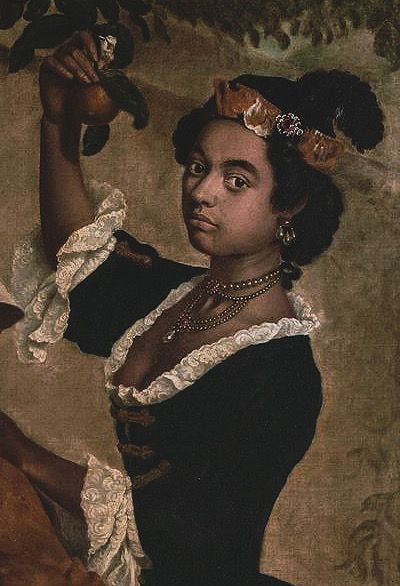
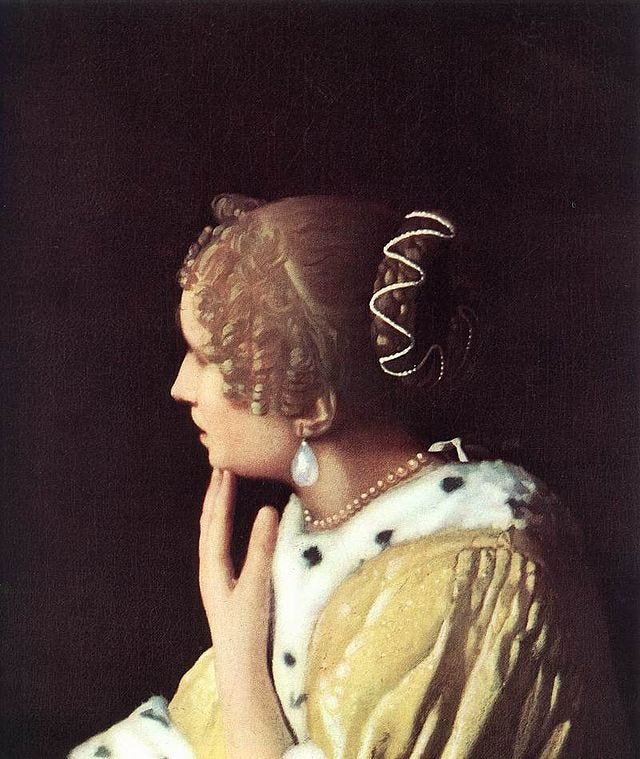
The Dutch Republic participated in the thriving trade in pearls. The Gulf of Mannar was “…one of the pearl diving hotspots in the 17th century.”10 Divers sometimes had to collect more than 1,000 oysters before they came across a single attractive pearl.
This overconsumption led to the rise in cultured pearls at the end of the 19th century. The first successfully cultured pearl was achieved in 1893 by the “Pearl King” Kokichi Mikimoto, founder of the luxury jewelry company, Mikimoto!
“My dream is to adorn the necks of all women around the world with pearls.” —founder Kokichi Mikimoto
Dragons, Goddesses, & Queens
The pearl has been associated with beauty, love, wisdom, and purity across cultures. To the Greeks and Romans, pearls were the tears of the goddess Aphrodite, born from the sea foam. They believed that pearls promoted happiness in marriage and thus, were a symbol of purity and loyalty.
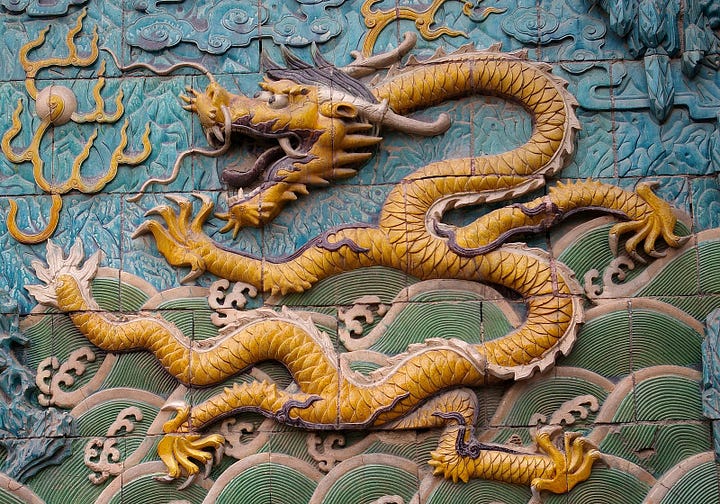
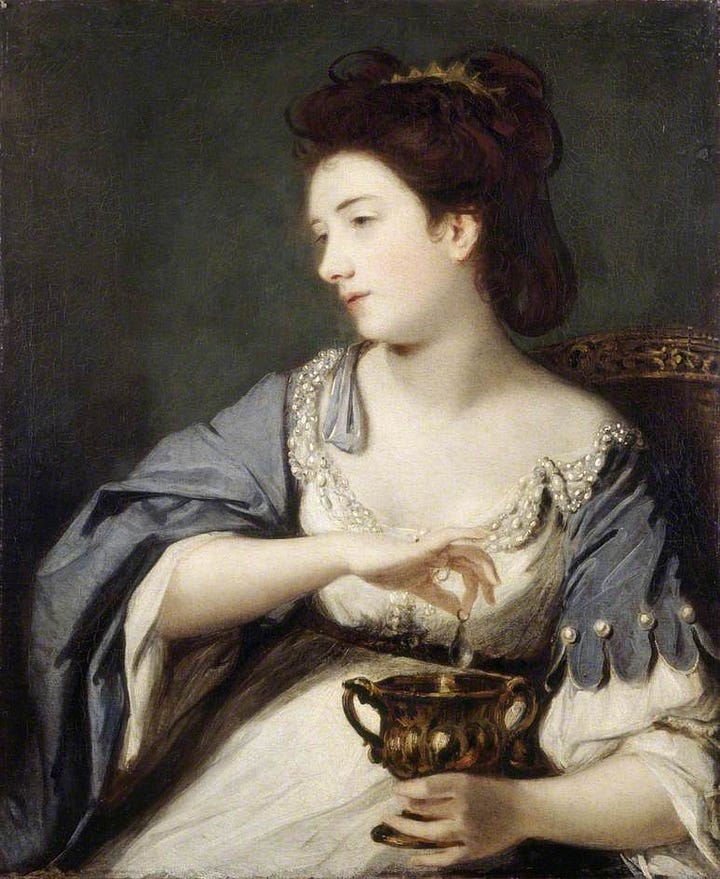
In his “Natural History,” Pliny the Elder describes how Cleopatra (69 BCE - 30 BCE), the Egyptian queen, dissolved a large expensive pearl earring — “the largest […] of all time…” — in vinegar, and drank it, to win a bet against Marc Anthony. She had wagered that she could spend 10 million sesterces [$500,000 on the gold standard] on one meal, and thanks to the pearl cocktail, she did. It was a brilliant power move by the Egyptian queen and a delightful show of Egypt’s wealth!
In ancient China, pearls were symbols of wisdom and purity, often depicted as being held by dragons. One legend set in the rural province of Sze Chuan, tells the story of a young boy who became a dragon by swallowing a magical pearl to protect it from the corrupt emperor. As a dragon, he became the protector of his province.
When it comes to learning about a gemstone and its place in history, you would be hard-pressed to find one as impactful and enduring as the pearl. From Europe to Asia and beyond, pearls have a place in just about every culture and myth. I hope you enjoyed this mini dive into the world of pearls – but the fun part is, it’s only just scratching the surface.
Until next time!
Post Script — Wow this is exciting and scary, but here goes! If you enjoy my writing please consider subscribing to have By Odette delivered to your inbox. Subscriptions are free! But if you’d like to support my writing, I’ve added a “Buy Me a Coffee” tip jar button below. No pressure at all and thank you so much for reading!
“Pearls; How They Are Produced, And Where,” Pliny the Elder, The Natural History, Book 9, Chapter 54. Perseus Tufts.
Joel E. Arem, Ph.D., FGA, et al., “Pearl Value, Price, and Jewelry Information,” International Gem Society (IGS), accessed Aug 11, 2024.
Edwin William Streeter, “The Servilia Pearl,” in Pearls and Pearling Life, University of Michigan: G. Bell & Sons, 1886, p. 280.
M. E. Deutsch, “Caesar and the Pearls of Britain,” In The Classical Journal, 19(8), 1924, pp. 503-505.
M. B. Flory, “Pearls for Venus,” on JSTOR. Historia: Zeitschrift für Alte Geschichte, 1988, p. 498.
Joel E. Arem, et al., “Pearl Value,” IGS.
Joel E. Arem, et al., “Pearl Value,” IGS.
Google Arts & Culture, with the Mauritshuis, et al., “Vermeer: A Painter of Pearls,” Google Vermeer Project, accessed August 12, 2024.
Google Arts & Culture, “Vermeer,” Google Vermeer Project.

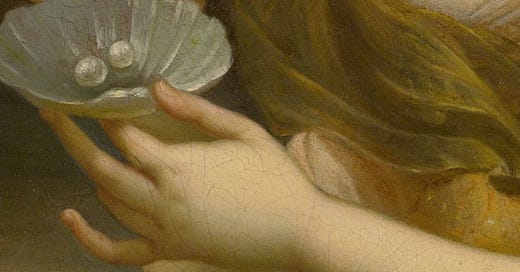






As someone who loves beautiful things, gems, and history, I’m enjoying this series! This article also happens to be perfect for the story I’m working on, which contains references to Caesar, Cleopatra and Aphrodite, so I think I’m going to be including some pearls!